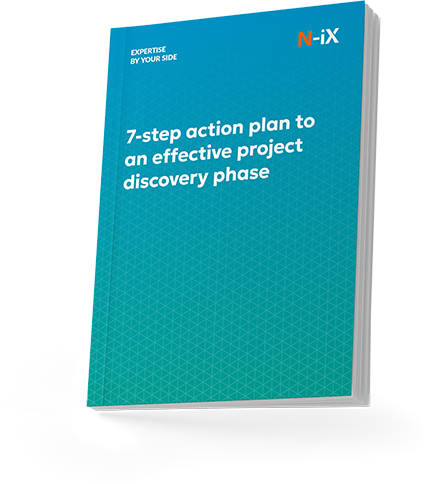Minimum Viable Product (MVP) delivery is often misunderstood. It’s seen as a way to build fast and cheap. But the truth is, MVPs are not shortcuts. When approached correctly, they are strategic tools for innovation, customer validation, and long-term success. When done wrong, they become expensive detours that cost credibility, capital, and time.
At N-iX, our Solution Group has helped dozens of organizations, ranging from Fortune 500s to rapidly scaling tech firms, navigate MVP development challenges and turn ideas into functional, scalable, and testable products.
In this article, we explore the most critical MVP software development challenges teams face and how enterprises can tackle them.
1. Creating a clear product vision and business objectives
One of the most critical mistakes in MVP development is starting without clearly defined goals. Too often, teams treat MVPs as a lightweight version of a full product, rather than a tool for validating specific assumptions.
So, our experts often begin our client engagements by asking: “What problem are you solving, and how will success be measured?” Surprisingly, even mature organizations struggle to answer this clearly.
A well-scoped MVP should be rooted in a strong product vision, aligned with measurable business goals. Without this clear vision, it becomes difficult to prioritize features, measure outcomes, or secure stakeholder alignment. The result is often scope creep, miscommunication, and a product that neither satisfies business needs nor delivers customer value.
How to do it?
-
Define the problem
Start with a specific, evidence-backed problem your target users face. Avoid vague goals like “improve user experience.” Instead, frame it like: “Enable users to schedule appointments in under two minutes to reduce drop-offs.” It is a good idea to use discovery techniques such as stakeholder interviews, user surveys, or customer journey mapping to clarify the problem.
-
Set measurable goals
Identify success criteria tied to the MVP’s purpose. This might include user activation rates, time to task completion, or the number of users who complete a key workflow. Keep metrics realistic and directly tied to learning outcomes (e.g., “Validate demand by onboarding 100 users in the first month”).
-
Align stakeholders early
Misalignment can derail the MVP. Run a cross-functional discovery workshop to agree on:
- The MVP’s goal and value proposition;
- Key assumptions to test;
- What will and will not be included in scope.
N-iX approach: We begin every engagement with a structured Product Discovery phase. Through stakeholder interviews, user persona development, journey mapping, and business case analysis, we ensure alignment between user needs and business goals from day one, eliminating ambiguity and setting a clear direction for development.
What happens without a proper Product Discovery? Let’s take a look at the next MVP development challenge.
2. Balancing speed and depth in the Product Discovery phase
Skipping discovery is one of the most common MVP software development challenges. Under pressure to show progress, teams often rush past this stage or skip it entirely, jumping straight into development based on assumptions. Validation through discovery ensures you’re solving a problem that matters before investing in solving it.
This shortcut often leads to wasted time and resources. Without understanding the market, user needs, and business context, teams risk building something no one needs or wants. Discovery is not just research; it is the foundation for making smart decisions throughout the MVP lifecycle.
At N-iX, we often see that even experienced product teams struggle to balance discovery with speed. Either the process is too shallow to be useful or so extensive that it delays delivery unnecessarily.
How to do it?
-
Focus on real user needs
Use qualitative methods like user interviews, contextual inquiry, and competitor analysis to understand the real problems users face, not just what stakeholders assume. Pair this with market research to assess trends, pain points, and demand drivers.
-
Map personas and user journeys
Define clear user types and the paths they follow to achieve goals. This helps identify friction points, feature opportunities, and what the MVP must support to deliver value.
-
Validate demand with lean experiments
Before committing to development, test your concept through landing pages, A/B tests, or clickable prototypes. Track how real users respond to your value proposition, not just how they answer surveys.
N-iX approach: We offer a structured, time-efficient discovery process designed to deliver actionable insights fast. N-iX experts conduct market research, develop user personas, map journeys, and evaluate technical feasibility. By combining business analysis with lean validation, we ensure you build what the market truly needs.
Set your project up for success—get our 7-step guide to a discovery phase!


Success!

3. Feature prioritization
Another one of MVP development challenges is deciding how much functionality to include. The goal is to launch something viable, not overbuilt, and not so minimal that it fails to deliver value.
In practice, many teams misunderstand what “viable” really means. Some try to pack in too many features to appeal to every stakeholder or user segment. Others reduce the scope to the point where the product no longer solves the core problem. Both approaches delay validation and increase the risk of failure.
A well-prioritized MVP focuses on a single value proposition, tested through a limited but meaningful set of features.
How to do it?
-
Start with your value hypothesis
Identify the core user need or job your product is meant to address. Every feature in the MVP should support this outcome directly. If it does not contribute to learning or user value, it should wait.
-
Apply structured prioritization frameworks
Use models like MoSCoW (Must have, Should have, Could have, Won’t have) or the Kano model to evaluate features objectively and avoid scope creep driven by opinions or internal politics.

-
Map features to the user journey
Ensure each core feature plays a role in a coherent end-to-end experience. Cut anything that interrupts or distracts from the main user path. This keeps the MVP focused and usable even with a limited feature set.
N-iX approach: Our product teams apply structured prioritization techniques and user story mapping to guide feature selection. We help clients stay focused on core functionality that validates the product’s value while ensuring the MVP is lean, functional, and ready for meaningful feedback.
Learn more about MVP outsourcing
4. Turning user feedback into product decisions
Collecting feedback is a core part of MVP development. But handling it without a clear strategy can do more harm than good. Many teams react to every comment or request, introducing changes that distract from the MVP’s purpose or slow down delivery.
The real MVP development challenge lies in using feedback to improve the product without losing focus. That means identifying which insights are worth acting on, who they come from, and how they align with your product goals.
How to do it?
-
Ask targeted questions
Before collecting any feedback, define what you’re trying to learn. Are you testing usability? Value perception? Feature clarity? Framing the right questions helps filter useful feedback from noise.
-
Segment responses by user profile
Not all users are equally valuable in the early stages. Group feedback by persona, behavior, or journey stage to understand which signals reflect your target audience and which do not.
-
Combine qualitative insights with behavioral data
User interviews and surveys provide context, but metrics like retention, drop-off points, and feature usage add objectivity. Look for patterns that align across both types of data before deciding what to adjust.
N-iX approach: We embed continuous, structured feedback loops into MVP development. Our teams combine analytics, usability testing, and real-user insights to surface actionable data at each stage. By aligning feedback with the product’s core goals, we help our clients iterate with clarity.
5. Choosing a scalable tech stack from the start
One of the most strategic decisions during MVP delivery is selecting the right technology foundation. Yet many teams treat MVPs as disposable, opting for tools that are quick to implement but difficult to scale.
This short-term thinking often leads to costly rewrites. The real MVP development challenge lies in balancing rapid delivery with architectural decisions that support future growth, integrations, and maintainability.
How to do it?
-
Align tech choices with your long-term product vision
Ensure your tech stack can evolve with your business needs. Prioritize technologies that support modular development, scalability, and cloud-native deployment.
-
Plan for integrations from day one
Use an API-first approach and design with third-party systems in mind. Flexibility here enables smoother enterprise adoption and future ecosystem expansion.
-
Keep architecture lean but extensible
Avoid overengineering, but structure your MVP to accommodate new features without rework. Focus on the separation of concerns and clear boundaries between components.
N-iX approach: Our solution architects design MVPs that are lean but built for growth. We choose scalable, cloud-native technologies and define CI/CD pipelines and integration points early. This ensures your MVP is ready for long-term evolution without sacrificing early speed.
6. Assembling the right team
Even a great product idea can fall short if the team building it lacks the right expertise. MVPs require a diverse skill set: UX design, engineering, DevOps, QA, and coordination across roles.
Another one of the MVP development challenges is putting together a team that can execute quickly while maintaining quality. Gaps in experience or unclear ownership often result in delays, misaligned features, or unstable builds.
How to do it?
-
Find a trusted MVP development partner
This will allow you to include UX designers, developers, QA engineers, and DevOps from day one. Assign a delivery owner to ensure alignment and accountability.
Moreover, outsourcing allows you to be flexible in terms of the MVP approach. For example, there are businesses that benefit from a concierge MVP, which is about delivering tailored, hands-on service to the initial users.
Read more about the top MVP development companies worldwide
-
Ensure delivery experience, not just technical skills
Look for team members with experience launching MVPs, not just building software. They will anticipate risks and manage trade-offs more effectively.
-
Augment your team when needed
If your internal team is stretched thin or lacks specific capabilities, bring in an external partner to fill the gaps and maintain velocity.
N-iX approach: We provide dedicated MVP teams with senior engineers, designers, QA experts, and delivery managers. Our teams are purpose-built for rapid delivery cycles, helping clients launch faster
7. Aligning stakeholders throughout the MVP lifecycle
MVPs often involve multiple departments: product, engineering, sales, compliance, and executive leadership. Without structured alignment, scope expands, priorities shift, and delivery stalls.
The challenge is managing expectations and keeping everyone focused on the same outcome.
How to do it?
-
Set expectations around what an MVP is (and is not)
Clarify the purpose, limitations, and success metrics of the MVP from the outset. This helps prevent overpromising or scope inflation.
-
Hold regular stakeholder check-ins
Use sprint reviews, milestone demos, and progress reports to maintain transparency and momentum across teams.
-
Create a shared roadmap and a single source of truth
Document goals, scope, and decision-making processes so that everyone works from the same baseline.
N-iX approach: Our delivery managers coordinate communication across all stakeholders. We use structured planning, demo cycles, and clear roadmaps to align business and technical teams, ensuring that decisions are fast, collaborative, and focused on results.
Keep reading: What makes MVP outsourcing the smart choice for enterprises
Final thoughts
MVPs are often misunderstood as shortcuts to product delivery, but as we have seen, they require strategic thinking, cross-functional alignment, and rigorous execution. From creating a clear product vision to ensuring stakeholder buy-in, navigating these challenges determines whether your MVP becomes a basis for growth or a costly misstep.
Partnering with N-iX to deliver impactful MVPs
At N-iX, we help businesses tackle these challenges head-on. As a full-cycle MVP development company with 23 years of experience, 2,400 tech experts, and operations in over [general:locations] countries, we deliver scalable MVPs with speed, precision, and enterprise-grade quality.
Our Solution Group brings together product discovery expertise, scalable architecture design, and senior engineering talent to guide you from idea to MVP and beyond. Whether you're validating a new concept or accelerating digital transformation, we build MVPs that are lean, functional, and built for scale.
Have a question?
Speak to an expert





